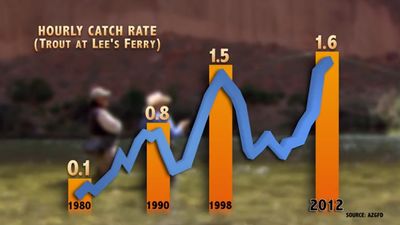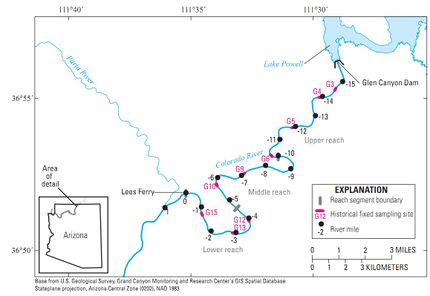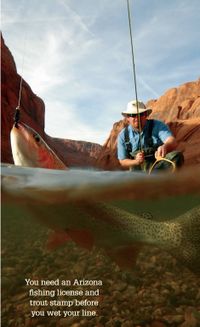|
APRIL 26 , 2016
UPRIVER REPORT
4
WALK-IN REPORT
4
SPIN REPORT
4
1 = GO ELSEWHERE
10 = GET HERE NOW!
CROWD REPORT
UPRIVER CROWD
1 WEEKDAY
2 WEEKEND
WALK-IN CROWD
1 WEEKDAY
1 WEEKEND
1 = SLEEP LATE AND FISH WHEREVER
10 = VERY CROWDED, GET UP EARLY
UP-RIVER SUMMARY
The spring fishing season at Lees Ferry has thus far been very interesting.
We have not been blessed with good weather;
it has been many years since we have seen strong winds like the ones we have experienced, with many days too windy and dangerous to launch our boats.
Good news is that the river saw an epic spawn this year. Up until the middle of April, just about every fish in the river was spawning and all was in the deeper water. This is good and bad … it made for tough fishing conditions: when fish spawn in the deep water it is tough to get a fly down to them and there were few fish in the shallows to fish to.
The good news is that the future is bright for the trout population to rebound since the survival of young trout is much better when the spawn is in deeper water. The spawning activity is decreasing and as this happens, the fish begin to assume more normal behavior. It takes awhile after fish spawn for them to begin normal feeding patterns and move back into the shallow water to feed on the emerging midges. The midge hatches are increasing daily and we are beginning to see a few more fish move back into the shallower water. This should continue to improve in May.
Most of our fishing has been from boats since the majority of the fish are still holding in deeper water. The best flies are midges and scuds. Long leaders and fine tippets along with adequate weight to get the flies to the bottom are the ticket to catching fish. Our best success has been using a 12- to 14-foot leader with a strike indicator near the fly line. Couple that with a #4 or BB spilt shot 18-inches above a #14 or #16 ginger scud with an #18 or #20 bead-head zebra midge underneath.
The water flows on the weekend are lower and the fishing has been much better. You can wade and reach areas where the fish are holding. The best fishing day of the week has been Sunday as the water starts low and rises very slowly during the day. We have fewer fish in the river today than we did 2 years ago, but we are seeing many more larger fish than in several years … the only problem is getting them to eat our flies.
This winter’s El Nino has been a big disappointment. The amount of snow delivered to the Lake Powell drainage basin sits at 80% of normal estimated snow pack. Last year, the situation was the same, but massive snow accumulation occurred late in the spring in what was dubbed the “Miracle May.” Perhaps we’ll get lucky and end up with a normal or above normal snow pack. Lake Powell is currently at 45% of capacity and at an elevation of 3,592 feet. Current runoff projections call for the lake to rise about 20 feet, very close to the same conditions that occurred in 2015.
The river looks great with abundant algae covering most of the bottom of the river. The algae indicates that there is a good nutrient flow from the water above the dam; these nutrients serve as the foundation the for macroinvertibrates that support the food web in the river.
Just because you caught fish in a certain spot in years past, don’t think that you are going to experience the same success in the same spot this year. Fishing changes daily. Stop by the shop to see the flies that are currently working. They change on a near-daily basis and the LFA guides let everyone at the shop know the top producing flies and how to use them. We are anxious to share this knowledge with you … even where to fish.
There has been an ongoing aquatic food base study over the past couple of years. The study’s purpose is multifaceted: the relationship of flows on food production, taking inventories of and monitoring populations of aquatic insects and invertebrates that live in the river and other important aspects of the aquatic food base. I believe that this is by far the most important study that has ever been conducted on this river. Previously, hundreds of millions of dollars have been spent studying sediment while ignoring the aquatic food base and resource. Common sense dictates that fish, birds and animals do not live off of dirt or sand. The aquatic food base and habitat are the foundation for all that lives in the Colorado River. One of the long term goals of the food base study is to determine how to enhance the populations and production of aquatic insects in the river which will benefit native fish, trout and migratory bird populations. This is a study and a goal that we can all embrace!
Quagga mussels have become established in Lake Powell and we are now seeing some in the river below the dam. Their arrival in the river happened sooner than I expected. So far, there has not been a major infestation and there is some thought by experts that they will not become very well established in the river due to the current. Be aware and remember to dry waders and boots before using them in any other body of water. Also, all private boats should drain all water from the boat and live-wells as soon as you exit the river. We all need to do our part to limit the transport of this and all invasive species.
WALK-IN SUMMARY
We are hearing a more positive reports on the walk-in fishing. The fishing has been improving weekly and keep in mind that the best fishing is on the lower water days…Saturday and Sunday. Seeing some epic midge hatches which should increase into May.
SPIN FISHING SUMMARY.
Spin fishing continues to be OK but the large amount of algae in the river is making it difficult to keep the lure clean and a trout will rarely eat a lure or fly that has algae attached.
Mercury levels in Glen Canyon trout
2015 News about the declining fish status at Fishery
Quick Facts
Visitor Use and Experience
- Visitor Experience as it relates to fisheries, include opportunities to fish for rainbow trout in GCNRA's Glen Canyon Reach, which has been referred to as Blue Ribbon by the State of Arizona, and to fish for rainbow and brown trout and a variety of non-native introduced fish species in the main stem Colrado River and some tributaries in GCNP. Most angling in GCNP occurs in or near Bright Angle Creek and Phantom Ranch, particularly in fall and spring (NPS 2006c)
Definition of Blue Ribbon fishery: Definition LINK
| 



